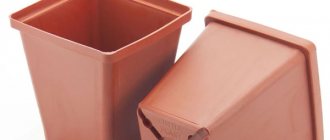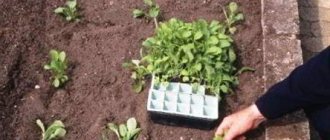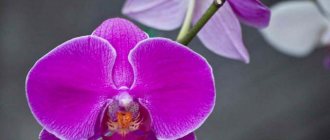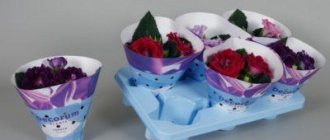Violets are very popular and sought-after indoor plants. With their decorativeness and variety of species and varieties, they captivate the hearts of flower growers.
Breeders managed to develop many forms and colors of this unique crop.
In this article I would like to talk about unusual varieties of green violets (Saintpaulias) and some secrets of caring for them.
After all, an important element of successfully growing a plant you like is studying its characteristics, and the experience of other gardeners helps a lot in this direction.
Top 10 most popular varieties
EK-Green Apples
A special feature of this variety are dense double flowers with light green outer petals. The center of the flower is blue.
The leaves are dark green. In cool conditions, the flower shows its shades more vividly.
PC-Green Corals
It features simple blue and white stars bordered by a bright green border.
The foliage of this purple variety is wavy, shiny, and medium green in color. Large leaves are often gnarled. Due to the dense and twisted foliage, the rosette cannot acquire a beautiful shape.
The flowers are dense, of an unusual ultramarine color. The edges of the petals are framed by a gray border. The shade of the petals and the edge of the flower can be of different saturation.
The process of flowering buds takes a long time, some of them do not have time to fully bloom. Flowering lasts about a month.
Attention! The plant does not bloom frequently or abundantly. Small flowers look lonely next to very large leaves.
AB-Cupid
A showy variety with single or semi-double white pansies, with a slight pinkish tint and a bright green wavy edge.
The foliage is quite large, shiny, sparkling, medium green in color; in high temperatures, a pink tint appears on the white petals of the flower.
Violet is characterized by abundant and long-lasting flowering. Many medium-sized flowers on strong and stable peduncles cover the plant with a “hat”.
This variety is distinguished by its unpretentiousness and fertility.
Fronzen in Time
An incredibly delicate variety with cupped white flowers resembling stars, bordered by a rich green border.
The plant is valued for its long flowering. The flowers sometimes take on a pale lilac color.
The foliage is variegated, green and white.
EK-Malachite orchid
Its large double flowers are rich cherry color with a wide green border around the edges.
When exposed to low ambient temperatures, the purple color turns almost completely green, leaving only the center of the cherry.
The rosette leaves have a pointed shape. The flowering period is approximately 3 months. Gems are usually collected in bunches.
The variety is characterized by intensive and unpretentious growth.
LE-Green Rose
The flowers of this variety resemble pansies, are colored soft pink and are framed by a green fringe along the edges of the petals. The foliage has a wavy shape and a glossy shine.
The border is green only when the buds open, then when the flower opens it turns yellow, and then completely loses color, becoming white.
Flower bouquet. Does not have a long flowering period. Fast growing variety.
Green Horizon
The flowers of this variety of Saintpaulia are double white stars with wide green stripes along the edges of the petals. Medium green foliage.
The saturation of green color in the petals of the bud manifests itself with the age of the rosette: the older it is, the larger and richer the flowers appear.
Important! This green and white purple plant boasts profuse and long-lasting blooms, fast growth and ease of propagation.
Allegro Pink Pistachio
A chic semi-miniature variety with green double roses framed by a crimson-red frill.
The foliage is light green in color, has a glossy surface and an elongated shape.
Flowering is almost continuous. A unique and incomparable variety.
RS-Miracle Lily of the Valley
The flowers of this variety of violets delight with their simplicity and tenderness.
They are bell-shaped, pink in color, with light green fringe along the edges of the petals. The bud never fully opens, hence the resemblance to a thrush.
The foliage is standard, light green. Flowering is long and abundant.
AB-Frog
The flower is similar to a pansy, semi-double, wavy, blue-white with a blue border and green upper petals.
The leaves are round, with jagged edges. The combination of colors in the bud looks very impressive.
Flowering is abundant and long lasting.
Recommendations for planting and care
In order for the night violet to grow and develop well, bloom for a long period of time and delight its owners, it is necessary to provide it with appropriate care conditions
It is important to choose the right place for her
Note! It is best to plant a flower after any type of cruciferous
Soil, illumination, degree of moisture
It is necessary to take into account the following requirements for the growing conditions of this flower:
- provide sufficient sun. Although the violet will feel good in partial shade;
- does not tolerate acidic soils well;
- the optimal soil type is loamy and fertile;
- It is advisable to prepare the land in the fall. To do this, you need to dig up the area, adding organic fertilizers.
Night violet is quite unpretentious. But, since the plant does not tolerate heat, it is necessary to provide good, abundant watering, especially in mid-summer. But if mattiola is planted ahead of schedule, then you don’t have to worry that the shoots may suffer from night frosts. Lyubka is a frost-resistant plant.
Important! In principle, all a flower needs is abundant lighting and intensive watering. She is unpretentious about everything else
Pest prevention
The night violet is most often exposed to the following diseases and parasites:
- fleas. To combat them, it is necessary to dust the bushes with ash or tobacco dust. Horse sorrel tincture has proven itself well, with which it is necessary to spray plants;
- clubroot is a fungal disease that can be avoided by planting matthiola after cruciferous vegetables. Otherwise, if the bushes become infected, they are removed and burned. The soil is treated with chemicals or lime;
- Butterfly caterpillars can infect greenery, thereby weakening the plant’s immunity. They need to be collected by hand or use insecticides.
Can it be planted indoors?
Matthiola is not planted indoors (at home). You can decorate the facade of your house with these flowers by planting them in hanging flowerpots or large flowerpots, which can also be placed on balconies.
Features of care
Green violet varieties are considered more demanding on storage conditions than others. This is due to the fact that their color characteristics are directly related to temperature, lighting conditions and regularity of watering.
In general, violets with green flowers are considered not very demanding plants; the main thing is to follow the basic recommendations for caring for them.
However, among these Saintpaulias one can distinguish green violets, which can be difficult to grow:
- LE-green rose;
- RS-Laguna Verde;
- Green Dragon;
- Green corals RS.
Watering
The watering regime is no different from the norms recommended for other varieties of Saintpaulia. It is important to water the plants with boiled water at room temperature.
Do not allow the soil to overflow or, conversely, dry out. Overmoistening of the soil can lead to the development of fungal diseases of the plant root system.
Violets cannot be poured or dried.
In addition, it is recommended to water at the root of the bush, without leaving a drop of water on the surface of the leaves, or to use the wick method of watering.
Air humidity
Increased air humidity will promote regular flowering. You can create it by placing a flower pot on an expanded clay tray filled with water.
Lighting
Most green violets require bright lighting due to their dark, dark green foliage.
Those varieties that have a lighter leaf part are able to grow in more shady conditions.
The most convenient place for placing green violets is considered to be an eastern or western window.
Advice! To ensure uniform formation of the rosette, it is necessary to periodically turn the pot with the plant over.
Optimal temperature
The most important criterion affecting the appearance and saturation of green color in Saintpaulia flowers is the temperature regime.
To develop a green tint, purple must create conditions of a comfortable temperature, no higher than 20 degrees. As it increases, the green color becomes less noticeable and subsequently disappears completely.
Feeding
Most green violets have wavy foliage, a sign of slow growing plants. Therefore, nitrogen fertilizers must be regular and balanced. In addition, it is recommended to ensure that the soil acidity level is close to neutral.
Violet Green Rose: photo and description
Violets are among the most sought after house flowers. Many beginners and experienced flower growers highly value them for their beauty, richness of colors and unpretentiousness.
The Green Rose violet stands apart from other varieties. The sophistication of the flower shapes makes it a real queen, distinguishing it from other flowers of this species.
Therefore, it will be useful for every florist to learn more about it.
Description
First, let's give a description of the Green Rose violet.
Its leaves are large and slightly wavy at the edges. The predominant color is beautiful, rich dark green. Growth proceeds from the center to the edges, resulting in the formation of a strong rosette.
But, of course, the main feature of the variety is its gorgeous flowers. They consist of numerous petals with wavy edges, arranged in the same way as in rose flowers - hence the name. At the edges the petals are pale yellow or even light green. There are also exquisite inclusions – strokes of lilac color. During one flowering, 6-7 flowers are usually formed.
Moreover, with a new flowering, the shade and structure of the flowers can differ significantly - this makes the growing process especially interesting. Colors can also be affected by ambient temperature. If the temperature drops below +20 degrees Celsius, then light colors predominate - yellow and light green.
But if the room is hot - above +26 degrees, then a large number of purple and even crimson inclusions appear on the petals. Of course, when choosing a sprout, any florist expects that it will retain the characteristics of the parent plant. However, this is not always observed in violets. Quite often, a young plant has flowers of a different color, very different from the flowers of its parents.
Such specimens are usually called “sport”. Violet Green Rose is no exception. Therefore, you should be prepared for this.
Suitable soil and pot
Before you start breeding violets, you need to take care of suitable growing conditions. There are several subtleties here that are very important to know about.
First of all, the pot. It would seem that everything is simple here - any container with drainage holes in the lower part will do, so that excess moisture can be freely removed without leading to rotting of the root system. However, the size of the plant should be taken into account here. It is not worth planting a tiny violet in a large pot.
Otherwise, the plant will devote all its efforts to developing the root system. This will take many months and all this time the violet will not bloom - hardly anyone will be happy with this situation. Therefore, it is advisable to plant a small leaf with roots in a small pot. Then the root system will quickly occupy the entire available volume and the plant will finally begin to bloom.
Over time, the grown plant will need to be replanted - we’ll talk about this a little later.
The choice of soil also needs to be taken very seriously. It is advisable to use fertile soil - black soil or any other soil mixed with compost - an excellent fertilizer. If the soil is too dense, then it would be a good idea to slightly dilute it with sand to facilitate the passage of moisture and oxygen to the roots.
Of course, it is advisable to pour a little crushed stone or pebbles at the bottom of the pot, and only then pour soil on top of them - then the plant will develop most quickly.
Correct conditions
In order for the violet of the Green Rose variety to actively grow and develop, it is necessary to provide it with certain conditions. First of all, these are humidity, temperature and lighting. Let's look at each of the parameters in more detail.
Like most violets, this variety prefers high air humidity - 50% or more. However, at home, this indicator is quite difficult to maintain - especially in winter, when radiators and heating devices dry out the air. Therefore, it would be a good idea to use a special humidifier or simply spray the plants with a spray bottle once or twice a day.
In general, violets are not too demanding on temperature conditions, successfully developing in a fairly wide range. But still, they grow best at temperatures from +18 to +30 degrees Celsius. As mentioned above, the appearance of flowers depends on this indicator.
Any plant needs a sufficient amount of light so that the process of photosynthesis actively occurs in the leaves. In summer there are usually no problems - there is enough lighting. True, you need to make sure that the violet does not get burned from direct sunlight - it is better to place the pot not on the south side.
Otherwise, overheating will cause the leaves and flowers to wither and then dry out. But in winter there is clearly not enough light. Therefore, in order for the plant to develop successfully, it is necessary to provide them with a sufficient amount of artificial lighting.
Fortunately, coping with the task is not at all difficult - just install a fluorescent lamp on the window.
Germination and planting
Now let's talk about the propagation of Green Rose violets. Flowers are quite easy to germinate. If you see a beautiful plant from your friends, you can simply ask them to separate a single leaf from it.
Of course, it is advisable to choose an even, beautiful and large leaf, and not from the edge, but directly from the center - they receive the most nutrients, which is why they are the most viable.
After that, half the work is already done!
All that remains is to place the leaf in a small container of water. Make sure that the lower end (cut) is always in water and never dries out - this will lead to the death of the plant. But at the same time, only the cutting itself should come into contact with water, and not the leaf - otherwise excess moisture will have a bad effect on it, and even rot may appear.
After a few days, small roots will appear at the bottom of the leaf. So it’s time to plant the plant in the ground. What soil and pot to choose is described above.
All that remains is to moisten the soil well, dig a small hole in it, place a leaf there so that all the roots are in the hole, and carefully cover it with soil on top, lightly compacting it for density.
That's all! Now the plant will probably actively grow and develop.
A little about watering
Violets should be watered as the soil dries. Accordingly, this will have to be done more often in the summer, and less often in the winter. In addition, the soil dries out faster in small pots than in large ones.
Watering should be done only with settled water - not cold from the tap.
It is advisable to pour water into a suitable container - a glass, jar or any other with a wide neck (to facilitate the process of chlorine evaporation) and leave for a day.
During this time, it will warm up to room temperature and get rid of dangerous chlorine. Too hot or cold water may well lead to diseases and damage to the roots.
When watering, try to pour water directly onto the ground. If it gets on the leaves on a hot sunny day, burns are possible - white spots will appear on their surface.
Transplantation
It was already mentioned above that violets need to be replanted regularly. Up to one year it can easily grow in a small pot. But then you should transplant it into a larger pot and repeat the procedure every two years.
Old plants especially cause a lot of trouble. It is not enough to simply replant them - you need to carefully remove the outer leaves directly from the rhizome, leaving only the middle. This rejuvenation of plants leads to active growth.
With young violets everything is much simpler. You need to prepare a pot into which you plan to transplant the plant, pour soil into it and make a large depression in it.
The soil in the pot with the violet needs to be slightly moistened, and then carefully turned over, trying to shake it out along with the plant - here it is very important not to damage the root system, otherwise the violet will hurt and may even die.
All that remains is to place the soil in the prepared hole and water it well.
Don't forget about fertilizers
For the first six months after planting in fresh soil, there is no need to fertilize the violet - the soil contains all the necessary substances. Then you need to feed the flower every two weeks - this is especially important during the flowering period.
An actively growing plant needs to be fertilized with nitrogen fertilizers - they ensure rapid growth of green mass (stems, leaves). Immediately after transplanting, you can add a little phosphorus, which is needed for the rapid development of the root system. But before flowering, you need to fertilize the violet with potassium fertilizers - then there will be more buds and their size will also increase.
Of course, when fertilizing, carefully study the instructions so as not to harm the plant due to excess microelements.
Possible difficulties during cultivation
Most often, violet lovers encounter aphids and mites. The appearance of aphids can be noticed by the gradually curling leaves. The problem is solved after treating the leaves with a special powder preparation - “Mospilan”.
Mites most often appear on old, drying leaves. Therefore, if you spend at least a few minutes a couple of times a week removing dry leaves, you will probably not encounter this problem.
Conclusion
This concludes our article. Now you know more about the Green Rose violet. The photo and description of the variety given in the article will allow you to recreate the most complete picture possible. Therefore, it will be easy to decide whether this plant is right for you or whether it is better to choose another option.
Source: https://labuda.blog/256772











